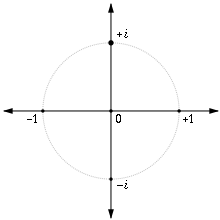−1
In mathematics, −1 is the additive inverse of 1, that is, the number that when added to 1 gives the additive identity element, 0. It is the negative integer greater than negative two (−2) and less than 0.
| |||||
|---|---|---|---|---|---|
[[{{#expr: (floor({{{number}}} div {{{factor}}})) * {{{factor}}}+({{{1}}}*{{{factor}}} div 10)}} (number)|{{#switch:{{{1}}}|-1={{#ifexpr:(floor({{{number}}} div 10)) = 0|-1|←}}|10=→|#default={{#expr:(floor({{{number}}} div {{{factor}}})) * {{{factor}}}+({{{1}}}*{{{factor}}} div 10)}}}}]] [[{{#expr: (floor({{{number}}} div {{{factor}}})) * {{{factor}}}+({{{1}}}*{{{factor}}} div 10)}} (number)|{{#switch:{{{1}}}|-1={{#ifexpr:(floor({{{number}}} div 10)) = 0|-1|←}}|10=→|#default={{#expr:(floor({{{number}}} div {{{factor}}})) * {{{factor}}}+({{{1}}}*{{{factor}}} div 10)}}}}]] [[{{#expr: (floor({{{number}}} div {{{factor}}})) * {{{factor}}}+({{{1}}}*{{{factor}}} div 10)}} (number)|{{#switch:{{{1}}}|-1={{#ifexpr:(floor({{{number}}} div 10)) = 0|-1|←}}|10=→|#default={{#expr:(floor({{{number}}} div {{{factor}}})) * {{{factor}}}+({{{1}}}*{{{factor}}} div 10)}}}}]] [[{{#expr: (floor({{{number}}} div {{{factor}}})) * {{{factor}}}+({{{1}}}*{{{factor}}} div 10)}} (number)|{{#switch:{{{1}}}|-1={{#ifexpr:(floor({{{number}}} div 10)) = 0|-1|←}}|10=→|#default={{#expr:(floor({{{number}}} div {{{factor}}})) * {{{factor}}}+({{{1}}}*{{{factor}}} div 10)}}}}]] [[{{#expr: (floor({{{number}}} div {{{factor}}})) * {{{factor}}}+({{{1}}}*{{{factor}}} div 10)}} (number)|{{#switch:{{{1}}}|-1={{#ifexpr:(floor({{{number}}} div 10)) = 0|-1|←}}|10=→|#default={{#expr:(floor({{{number}}} div {{{factor}}})) * {{{factor}}}+({{{1}}}*{{{factor}}} div 10)}}}}]] [[{{#expr: (floor({{{number}}} div {{{factor}}})) * {{{factor}}}+({{{1}}}*{{{factor}}} div 10)}} (number)|{{#switch:{{{1}}}|-1={{#ifexpr:(floor({{{number}}} div 10)) = 0|-1|←}}|10=→|#default={{#expr:(floor({{{number}}} div {{{factor}}})) * {{{factor}}}+({{{1}}}*{{{factor}}} div 10)}}}}]] [[{{#expr: (floor({{{number}}} div {{{factor}}})) * {{{factor}}}+({{{1}}}*{{{factor}}} div 10)}} (number)|{{#switch:{{{1}}}|-1={{#ifexpr:(floor({{{number}}} div 10)) = 0|-1|←}}|10=→|#default={{#expr:(floor({{{number}}} div {{{factor}}})) * {{{factor}}}+({{{1}}}*{{{factor}}} div 10)}}}}]] [[{{#expr: (floor({{{number}}} div {{{factor}}})) * {{{factor}}}+({{{1}}}*{{{factor}}} div 10)}} (number)|{{#switch:{{{1}}}|-1={{#ifexpr:(floor({{{number}}} div 10)) = 0|-1|←}}|10=→|#default={{#expr:(floor({{{number}}} div {{{factor}}})) * {{{factor}}}+({{{1}}}*{{{factor}}} div 10)}}}}]] [[{{#expr: (floor({{{number}}} div {{{factor}}})) * {{{factor}}}+({{{1}}}*{{{factor}}} div 10)}} (number)|{{#switch:{{{1}}}|-1={{#ifexpr:(floor({{{number}}} div 10)) = 0|-1|←}}|10=→|#default={{#expr:(floor({{{number}}} div {{{factor}}})) * {{{factor}}}+({{{1}}}*{{{factor}}} div 10)}}}}]] [[{{#expr: (floor({{{number}}} div {{{factor}}})) * {{{factor}}}+({{{1}}}*{{{factor}}} div 10)}} (number)|{{#switch:{{{1}}}|-1={{#ifexpr:(floor({{{number}}} div 10)) = 0|-1|←}}|10=→|#default={{#expr:(floor({{{number}}} div {{{factor}}})) * {{{factor}}}+({{{1}}}*{{{factor}}} div 10)}}}}]] [[{{#expr: (floor({{{number}}} div {{{factor}}})) * {{{factor}}}+({{{1}}}*{{{factor}}} div 10)}} (number)|{{#switch:{{{1}}}|-1={{#ifexpr:(floor({{{number}}} div 10)) = 0|-1|←}}|10=→|#default={{#expr:(floor({{{number}}} div {{{factor}}})) * {{{factor}}}+({{{1}}}*{{{factor}}} div 10)}}}}]] [[{{#expr: (floor({{{number}}} div {{{factor}}})) * {{{factor}}}+({{{1}}}*{{{factor}}} div 10)}} (number)|{{#switch:{{{1}}}|-1={{#ifexpr:(floor({{{number}}} div 10)) = 0|-1|←}}|10=→|#default={{#expr:(floor({{{number}}} div {{{factor}}})) * {{{factor}}}+({{{1}}}*{{{factor}}} div 10)}}}}]] | |||||
| Cardinal | −1, minus one, negative one | ||||
| Ordinal | −1st (negative first) | ||||
| Arabic | −١ | ||||
| Chinese numeral | 负一,负弌,负壹 | ||||
| Bengali | −১ | ||||
| Binary (byte) |
| ||||
| Hex (byte) |
| ||||
Negative one bears relation to Euler's identity since eiπ = −1.
In software development, −1 is a common initial value for integers and is also used to show that a variable contains no useful information.
Negative one has some similar but slightly different properties to positive one.[1]
Algebraic properties
Multiplying a number by −1 is equivalent to changing the sign on the number. This can be proved using the distributive law and the axiom that 1 is the multiplicative identity: for x real, we have
where we used the fact that any real x times 0 equals 0, implied by cancellation from the equation
In other words,
so (−1) · x, or −x, is the arithmetic inverse of x.
Square of −1
The square of −1, i.e. −1 multiplied by −1, equals 1. As a consequence, a product of two negative real numbers is positive.
For an algebraic proof of this result, start with the equation
The first equality follows from the above result. The second follows from the definition of −1 as additive inverse of 1: it is precisely that number that when added to 1 gives 0. Now, using the distributive law, we see that
The second equality follows from the fact that 1 is a multiplicative identity. But now adding 1 to both sides of this last equation implies
The above arguments hold in any ring, a concept of abstract algebra generalizing integers and real numbers.
Square roots of −1
Although there are no real square roots of -1, the complex number i satisfies i2 = −1, and as such can be considered as a square root of −1. The only other complex number whose square is −1 is −i because by the fundamental theorem of algebra, there are exactly two square roots of any nonzero complex number. In the algebra of quaternions (where the fundamental theorem does not apply), which contain the complex plane, the equation x2 = −1 has infinitely many solutions.
Exponentiation to negative integers
Exponentiation of a non-zero real number can be extended to negative integers. We make the definition that x−1 = 1/x, meaning that we define raising a number to the power −1 to have the same effect as taking its reciprocal. This definition is then extended to negative integers, preserving the exponential law xaxb = x(a + b) for real numbers a and b.
Exponentiation to negative integers can be extended to invertible elements of a ring, by defining x−1 as the multiplicative inverse of x.
A −1 that appears as a superscript of a function does not mean taking the (pointwise) reciprocal of that function, but rather, the inverse function (or more generally inverse relation) of the function. For example, f−1(x) is the inverse of f(x), or sin−1(x) is a notation of arcsine function. When a subset of the codomain is specified inside the function, it instead denotes the preimage of that subset of the codomain under the function.
See also
References
- Mathematical analysis and applications By Jayant V. Deshpande, ISBN 1-84265-189-7
